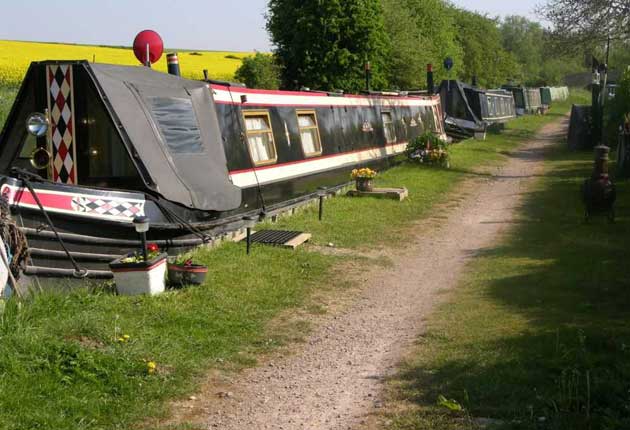Take the plunge: canalboat living
More than 15,000 people now live on Britain's canals. Jimmy Lee Shreeve reports

When his brother-in-law asked if he'd take a narrowboat up to York from Staffordshire for him, Andrew Denny said, "Yes, why not? It could be fun." This was just less than 20 years ago and proved to be life-changing. "It was a favour for a family member," he says. "I was 39 at the time and I'd never been interested in boats before, but that trip captured my imagination. I fell in love with canal boating."
He sold his London flat, bought a narrowboat and started chronicling his adventures on a blog, www.grannybuttons.com, named after his boat. His PR job demands he be moored in one place some of the time, but he is happiest drifting along Britain's canal network. "It brings such a sense of freedom," he says. "No ties and a slower, more contemplative pace of life."
Another long-time fan of canal living is the actor Timothy West. While with the RSC in Stratford-upon-Avon, he lived on a narrowboat. Today, he and his wife, Prunella Scales, spend some of the year living on canals. "For 30 years, we've loved seeing the country from a different viewpoint, at a gentle four miles per hour, enjoying the wildlife, the canal-side community, and the pubs," he says.
There are around 15,000 "liveaboards", as they are known, living on Britain's canals. Patrick and Jane Cruise fell in love with narrowboats after living on one they'd bought for holidays in between house moves. "We moved into a house and couldn't settle," Jane says. "So we bought a longer boat, which we decided to live on." What they appreciate most is the sense of community among liveaboards. "Everyone is so friendly," says Patrick. "It's like going back to the 1950s, when everybody helped each other. It's not a selfish way of living at all. It's great."
Most liveaboards agree that buying a narrowboat is less complicated than buying a house. "There are things you do need to do when buying a boat," says Nick Corble, a waterways enthusiast, who co-wrote Living Aboard (History Press 2008) with Allan Ford. "You need to get insurance (around £300 a year) and sign a form transferring ownership, so the British Waterways Board knows whose boat is whose, and you need to sort out moorings. But it's less hassle than buying a house." Another requirement is a boat safety certificate – like a car MOT – which costs £100 a year.
The best place to buy a narrowboat is a marina, where you can find a broker (like an estate agent). "You can go up to £100,000 or £200,000, but it'd be a floating palace, and you'd probably be too scared to take it out," says Corble. "You can get a good second-hand boat for between £25,000 and £30,000." Once you've decided on a boat, get a survey done (around £500). The general soundness will be checked and, crucially, the state of the steel hull. "The last thing you want to do is spend a lot of money and the bottom of the boat falls off," says Patrick Cruise.
Finding a mooring is less straightforward. "It's harder than buying a boat," says Allan Ford. "I recommend people find a mooring first, so when they've bought a boat they've got somewhere to take it." There are three different approaches to mooring. You can have a permanent mooring, which might be in a marina, on a towpath, or on a stretch of land you own. Alternatively, you can cruise through summer and take a mooring in winter – an option popular with retired people. The third option is to be a continuous cruiser, which means you can only stay in one place for 14 days. "Continuous cruising sounds great on the surface," says Ford. "But the novelty soon wears off. Sooner or later, you're going to need a mooring."
There are also running costs. The 200-year-old, 2,200-mile network of canals and rivers costs more than £100m a year to maintain. Some comes from the government, but £20m of it has to be raised through a licence fee. Depending on the length of the boat, this is around £600 a year, and gives you access to fresh water and sewage-disposal stations. Then there's maintenance costs. Patrick and Jane Cruise say the running costs for their boat are about £2,200 a year.
"If you're mechanically minded, you can service the engine and change the filters yourself," says Patrick. "But every two or three years, your boat will need to come out of the water and have the hull blacked [rust-proofing with tar]. For a 60ft-long vessel like ours, this costs around £750."
You can have internet access (wi-fi on a marina and mobile internet elsewhere) and digital TV, washing machines, microwaves and other mod cons. Most boats are heated by a wood- or coal-burning stove, and some boats also have gas central heating. "So long as your boat is properly insulated, it's not cold in winter," says Nick Corble. "It can be very snug and you waste far less energy than in a house."
There are many points where you can fill your water tanks, but toilet facilities can be a bind. "Our toilet flushes into a built-in holding tank, which I empty via a pump when we get to a British Waterways disposal point," says Patrick Cruise. Other boaters use cassette sewage tanks, which can be emptied at sanitary stations.
But one of the most crucial things to remember is which side you've moored the vessel. "Late one evening a few years ago, I stepped straight into the canal," laughs Patrick Cruise.
More information
* British Waterways - www.britishwaterways.co.uk
* Waterscape - www.waterscape.com
* Nick Corble - www.nickcorble.co.uk
* Granny Buttons blog - www.grannybuttons.com
Join our commenting forum
Join thought-provoking conversations, follow other Independent readers and see their replies
Comments